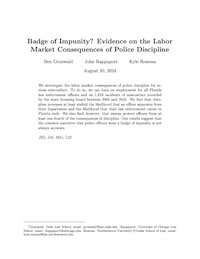By Ben Grunwald, John Rappaport, Kyle Rozema
We investigate the labor market consequences of police discipline for serious misconduct. To do so, we use data on employment for all Florida law enforcement officers and on 1,818 incidents of misconduct recorded by the state licensing board between 2000 and 2016. We find that discipline increases at least sixfold the likelihood that an officer separates from their department and the likelihood that their law enforcement career in Florida ends. We also find, however, that unions protect officers from at least one-fourth of the consequences of discipline. Our results suggest that the common narrative that police officers wear a badge of impunity is not always accurate.
Duke Law School Public Law & Legal Theory Series No. 2024-55,



